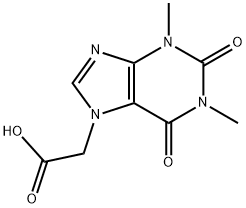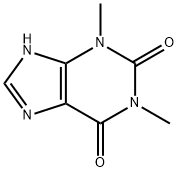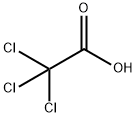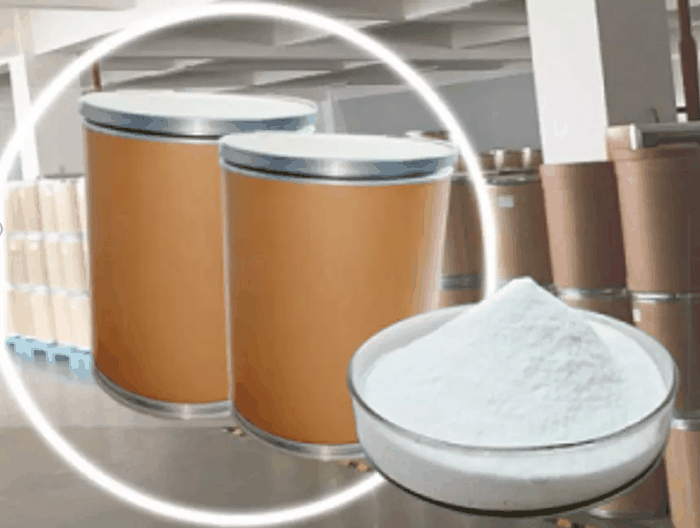Theophylline-7-acetic acid
Synonym(s):1,3-Dimethylxanthine-7-acetic acid
- CAS NO.:652-37-9
- Empirical Formula: C9H10N4O4
- Molecular Weight: 238.2
- MDL number: MFCD00022832
- EINECS: 211-490-2
- SAFETY DATA SHEET (SDS)
- Update Date: 2024-11-19 23:02:33

What is Theophylline-7-acetic acid?
Chemical properties
White Solid
The Uses of Theophylline-7-acetic acid
A xanthine derivative with bronchodilator activity. Typically combined as salt component with other medications such as Ambroxol to treat bronchial and pulmonary diseases.
The Uses of Theophylline-7-acetic acid
Bronchospasm;Adenosine receptor antagonist
Definition
ChEBI: 2-(1,3-dimethyl-2,6-dioxo-7-purinyl)acetic acid is an oxopurine.
Properties of Theophylline-7-acetic acid
| Melting point: | 270-272 °C |
| Boiling point: | 269-271 C |
| Density | 1?+-.0.1 g/cm3(Predicted) |
| storage temp. | Inert atmosphere,Room Temperature |
| solubility | DMSO (Slightly) |
| form | Solid |
| pka | 3.72±0.10(Predicted) |
| color | White |
| Merck | 14,24 |
| BRN | 279221 |
| CAS DataBase Reference | 652-37-9(CAS DataBase Reference) |
Safety information for Theophylline-7-acetic acid
| Signal word | Warning |
| Pictogram(s) |
 Exclamation Mark Irritant GHS07 |
| GHS Hazard Statements |
H315:Skin corrosion/irritation H319:Serious eye damage/eye irritation H335:Specific target organ toxicity, single exposure;Respiratory tract irritation |
| Precautionary Statement Codes |
P302+P352:IF ON SKIN: wash with plenty of soap and water. P305+P351+P338:IF IN EYES: Rinse cautiously with water for several minutes. Remove contact lenses, if present and easy to do. Continuerinsing. |
Computed Descriptors for Theophylline-7-acetic acid
Theophylline-7-acetic acid manufacturer
Kores India Limited (Kores Pharmaceuticals And Chemicals)
1Y
Phone:+912227613455
product: Acefylline 652-37-9 98%
New Products
(S)-3-Aminobutanenitrile hydrochloride 4-Methylphenylacetic acid N-Boc-D-alaninol N-BOC-D/L-ALANINOL Tert-butyl bis(2-chloroethyl)carbamate N-octanoyl benzotriazole 3-Morpholino-1-(4-nitrophenyl)-5,6-dihydropyridin- 2(1H)-one Furan-2,5-Dicarboxylic Acid S-2-CHLORO PROPIONIC ACID ETHYL ISOCYANOACETATE 2-Bromo-1,3-Bis(Dimethylamino)Trimethinium Hexafluorophosphate 4-IODO BENZOIC ACID 3-NITRO-2-METHYL ANILINE 1-(2,4-DICHLOROPHENYL) ETHANAMINE (2-Hydroxyphenyl)acetonitrile 4-Bromopyrazole 5,6-Dimethoxyindanone 2-(Cyanocyclohexyl)acetic acid 4-methoxy-3,5-dinitropyridine 1-(4-(aminomethyl)benzyl)urea hydrochloride 2-aminopropyl benzoate hydrochloride diethyl 2-(2-((tertbutoxycarbonyl)amino) ethyl)malonate tert-butyl 4- (ureidomethyl)benzylcarbamate Ethyl-2-chloro((4-methoxyphenyl)hydrazono)acetateRelated products of tetrahydrofuran








You may like
-
 652-37-9 Acefylline 98%View Details
652-37-9 Acefylline 98%View Details
652-37-9 -
 652-37-9 98%View Details
652-37-9 98%View Details
652-37-9 -
 Acefylline 98%View Details
Acefylline 98%View Details
652-37-9 -
 Acefylline 652-37-9 98%View Details
Acefylline 652-37-9 98%View Details
652-37-9 -
 652-37-9 Acefylline 99%View Details
652-37-9 Acefylline 99%View Details
652-37-9 -
 Theophylline-7-acetic Acid CAS 652-37-9View Details
Theophylline-7-acetic Acid CAS 652-37-9View Details
652-37-9 -
 Theophylline-7-acetic acid 95% CAS 652-37-9View Details
Theophylline-7-acetic acid 95% CAS 652-37-9View Details
652-37-9 -
 118753-70-1 98+View Details
118753-70-1 98+View Details
118753-70-1
Statement: All products displayed on this website are only used for non medical purposes such as industrial applications or scientific research, and cannot be used for clinical diagnosis or treatment of humans or animals. They are not medicinal or edible.